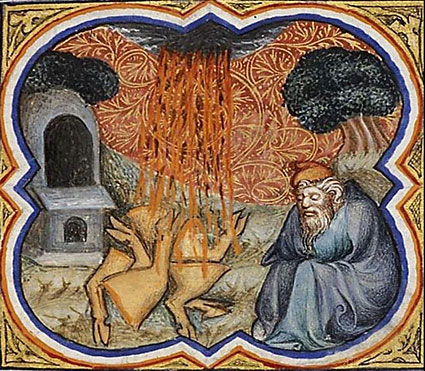Pass-over and Pass-through
Luke 4:30 “But he passing through the midst of them went his way…”
Why did Abraham not cut up the birds?
The structure of the passage has a “Passover“. Abraham acts as a human firmament by chasing away the “Covenant curse” birds of prey, then falls into a deep, dark sleep.
Matching this chiastically at step 6, the smoking firepot and blazing torch pass through the divided pieces at Atonement. But not through the birds, obviously.
Did the clean birds represent the Covenant people, just as the scavenging vultures represented the Covenant curses? What sins did the sacrifice atone for?
I think it must have been the sins of the Canaanites in the Land. Under Abraham’s ministry, it was they who were being passed over. Their sins were not yet full. But when Abraham’s children returned, the Canaanites would be passed THROUGH. The blazing torch (Ark – head – Joshua) and smoking firepot (Incense – body – Israel) would put the sword to the Canaanites and divide up the Land.
Abraham, then, was the Covenant head and the Gentiles were now under his ministry as body. Perhaps this also relates to the “body” linen in the tomb being separate from the head. The head is the dove/pigeon. It is the pure proto-kingdom, the dove dividing the Abyss.
James Jordan writes:
“The Spirit comes as a dove. This indicates to me that the Kingdom of God begins among the `poor’ of the earth, not usually among the mighty. It grows to embrace goats and bulls, but in the New Testament we do not find many priests (bulls) or the leaders of Israel and Rome (goats) forming the foundation of the kingdom.
Perhaps the larger meaning of this is that it is the poor in spirit, the doves and pigeons of God, who have the kingdom of heaven, as the first beatitude says (Matthew 5:3). Only those who see themselves as poor doves will look up to the Lamb. The bulls and goats of this world must assume the posture of poor doves and pigeons in order to recognise Him.” [1]
So, the land-dwelling clean animals were substituted for the current inhabitants of the Land. As a human barrier, a human firmament, the first true Jew, Abram stood in the gap between the (Noahic) Law and the condemned Canaanite nations. With their past sins atoned for, the Lord would allow “the sins of the Amorites” to grow to maturity while he simultaneously allowed the offspring of Abram to grow to maturity in Egypt.
In the sacrifices, while he slept, Abram as Adam was divided into Jew and Gentile, church and state, priest and people—head and body. Abram chased away the “destroyers” at Passover. Matching this at Atonement, the Lord’s glory-cloud, flame-and-smoke, Ark-and-Incense, head and body, passed through the divided sacrifice. A reunited and more glorious micro church-state would rise from the grave of Egypt to inherit the Land.
When Abram’s children returned to pass-through Canaan, there would be no more
animal substitutes, no more sacrifice for sins.
For if we go on sinning deliberately after receiving the knowledge of the truth, there no longer remains a sacrifice for sins, but a fearful expectation of judgment, and a fury of fire that will consume the adversaries. (Hebrews 10:26-27)
God’s new human army of destroyers would not be poor doves but glorious eagles, birds of prey to carry out the sentence of God upon those who had trampled the blood of this Covenant underfoot.
So, were the Canaanites warned? This is an important point for Christians faced with accusations of the Lord’s “brutality” through Joshua. Abram didn’t “call on” the name of the Lord. Literally, he proclaimed it.
James Jordan writes:
“It is important for us to reflect on the meaning of [Abram's] altars. They were not just places where Abram offered his personal worship. They were also worship centres for all the faithful in the area. Abram was an evangelist. This is not immediately obvious from the English translation, but in Genesis 12:5 we should read: ‘And Abram took Sarai his wife and Lot his nephew, and all their possessions which they had accumulated, and the souls that they had made in Haran…’ The distinguished Jewish commentator Umberto Cassuto explains that the verb we have translated ‘made’ is not the correct term for acquiring servants. Rather it indicates evangelisation. These people were not purchased but converted.” [2]
Of course we see this same pattern in the first century. AD30 was Passover. In AD70, Jesus and His new church state (including Abraham) passed through the midst of the Herodian Canaanites ”unmolested” and went their way. [3]
_______________________________________
[1] James B. Jordan, The Lamb of God, Part 2, BIBLICAL Horizons, No. 40.
[2] James B. Jordan, Primeval Saints: Studies in the Patriarchs of Genesis, pp. 64-65.
[3] See A New Land.


























